Stadthagen Branch
Roger P. Minert, “Stadthagen Branch, Bielefeld District,” in Under the Gun: West German and Austrian Latter-day Saints in World War II (Provo, UT: Religious Studies Center, Brigham Young University; Salt Lake City: Deseret Book, 2011), 60–68.
Located twenty miles west of the major city of Hanover, the town of Stadthagen had been home to a strong branch of The Church of Jesus Christ of Latter-day Saints since the early twentieth century. When World War II began, there were sixty-six members in the branch, including nineteen holders of the priesthood, in a town with a population of 28,389. [1] Several leaders in the Bielefeld District called this branch their home, principally district president Alfred Hegemeister.
According to the directory of the West German Mission in Frankfurt, the president of the Stadthagen Branch in the fall of 1939 was Karl Borcherding Sr. of nearby Ottensen. [2] Heinrich Rahde and Wilhelm Tegmeier Sr. were his counselors. There were at that time leaders and secretaries for all organizations and programs with the exception of the Primary, possibly because only seven children were on the branch rolls.
Church meetings were held in rented rooms on Niedernstrasse 25 as the war approached. Sunday school began at 9:30 a.m., and sacrament meeting followed at 11:00. All Sunday meetings were held consecutively. The mission office directory indicates that Priesthood and Relief Society meetings were held after the close of sacrament meeting. At that time, no branch meetings were held during the week.
Young Fred Wehrhahn (born 1937) recalled the setting of the meeting rooms:
The first building was an old horse stable. The people who owned that old farmhouse had had horses at one point. I remember that we always had to enter the rooms through the actual farmhouse—through theDiele(hallway). The horse stable had been converted to our meeting rooms. They had cleaned it out and had done some remodeling so we could have more classrooms. . . . It was on the ground floor. I recall that we always had a picture on the wall of the Prophet Joseph Smith. My father would always take the time to tell us about the Prophet Joseph and his visitation by the Father and the Son. We had a pump organ for our music. [3]
| Stadthagen Branch[4] | 1939 |
| Elders | 7 |
| Priests | 6 |
| Teachers | 2 |
| Deacons | 4 |
| Other Adult Males | 9 |
| Adult Females | 31 |
| Male Children | 5 |
| Female Children | 2 |
| Total | 66 |
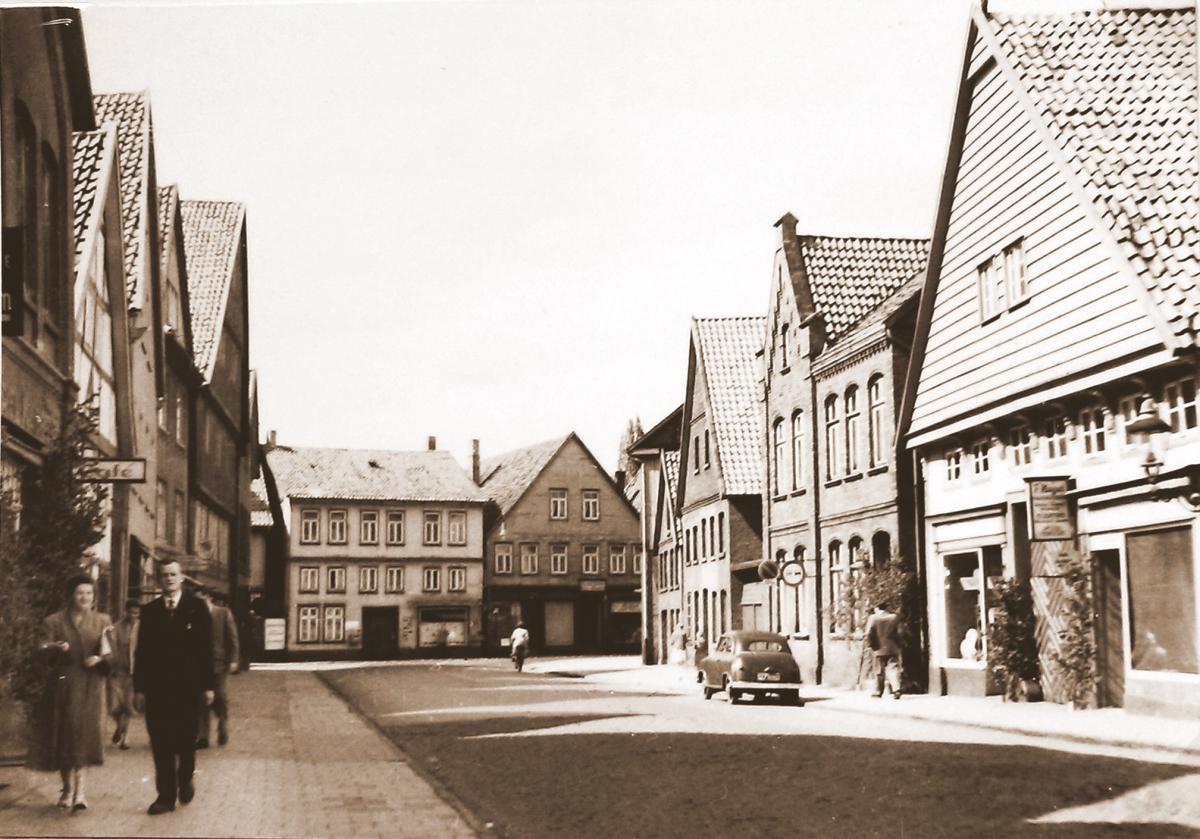 Fig. 1 The first house on the right is Niederstrasse no. 25 as it appeared in the 1940s. (K. Borcherding)
Fig. 1 The first house on the right is Niederstrasse no. 25 as it appeared in the 1940s. (K. Borcherding)
According to the official branch minutes, worship services and other branch activities carried on without interruption during the first years of the war. For example, on February 18, 1940, seven members of the Stadthagen Branch traveled to Bielefeld to attend the district conference. [5] In June, all Sunday meetings were moved to the morning hours. By October, when Sunday School was changed to 1:00 p.m. and followed by sacrament meeting, the average attendance had declined from twenty to thirteen. [6]
The branch Christmas party of 1941 was attended by forty persons. By the summer of the next year, Sunday meetings were again held in the forenoon, but only ten persons were still coming faithfully. In October, the meetings were again moved to the afternoon. There are no explanations given for the schedule changes. [7]
Attached to the Stadthagen Branch but too far away to attend very often were perhaps a dozen Latter-day Saints living in the town of Alverdissen, about twenty miles south. Werner Jacobi (born 1928) recalled the following about the group there:
In Alverdissen, we sometimes had up to twelve people. We would meet in members’ homes. I remember the Franzheimer family and lady who we called Tante Minna. . . . We had [musical instruments] to sing with. We attended district conferences now and then in Bielefeld or Stadthagen. My parents had all scriptures in our home—I knew of the Book of Mormon, and we also made sure that we read in it regularly. [8]
Werner was a member of the Jungvolk and later the Hitler Youth. He enjoyed the activities of both organizations and was especially talented in sports. He believed there was a specific reason for his athletic prowess: “Because I kept the Word of Wisdom, I was always the best—best at the 100 meter dash and the long jump. Because of that, nobody made any fun of me or caused any trouble. I was simply the best in all those athletic activities.” Werner’s father objected to Hitler’s politics and complained about the Hitler Youth program but could not prevent his son from participating in the program.
Several older members of the Stadthagen Branch passed away during the war, and their funerals were reported in the branch meeting minutes, but only once is a military death found, namely on February 15, 1942: “Fritz Bothe died of wounds at the Russian Front.” [9] The minutes were apparently kept for the most part by Heinrich Rahde. Very complete, neat,and correct, the entries contain specific details on each meeting’s attendees by member category (priesthood holders, women, children,and friends). Brother Rahde was clearly dedicated to his calling as branch secretary.
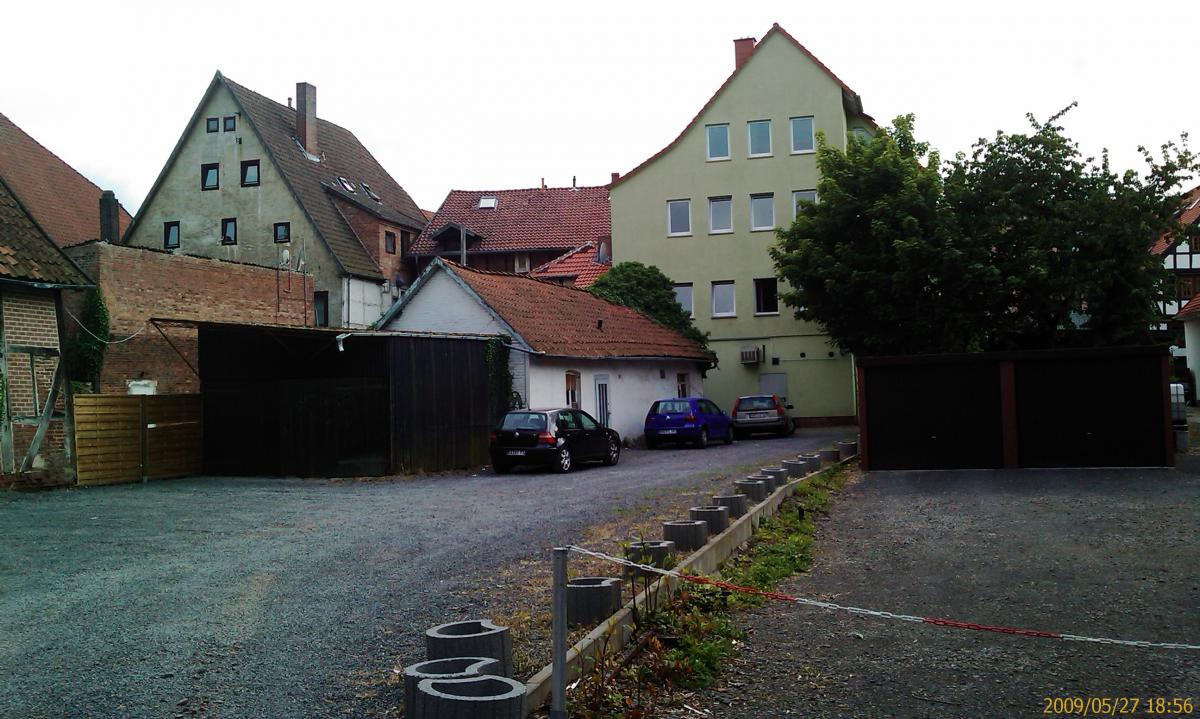 Fig. 2. The structure in which the branch met during the war stood behind house no. 25—almost exactly where the small white building in this picture now stands. (K. Borcherding)
Fig. 2. The structure in which the branch met during the war stood behind house no. 25—almost exactly where the small white building in this picture now stands. (K. Borcherding)
Fred Wehrhahn’s parents were Karl and Alwine. The family lived in the town of Ehlen, about two miles southwest of Stadthagen. Brother Wehrhahn had worked as a miner but was then employed in a glass factory in Obernkirchen. Shortly after the war began, he was drafted into the Wehrmacht, and his wife and children moved into an apartment house in Obernkirchen.
Even little children can have distinct memories, as was the case with Fred Wehrhahn: “My father was drafted in 1939. Even though I was only two years old, I can still remember that vividly. My father had gotten permission to come home because my mother was ready to give birth to my little sister. I admired him for his uniform and for carrying a gun on his belt. That made an impression on my mind.”
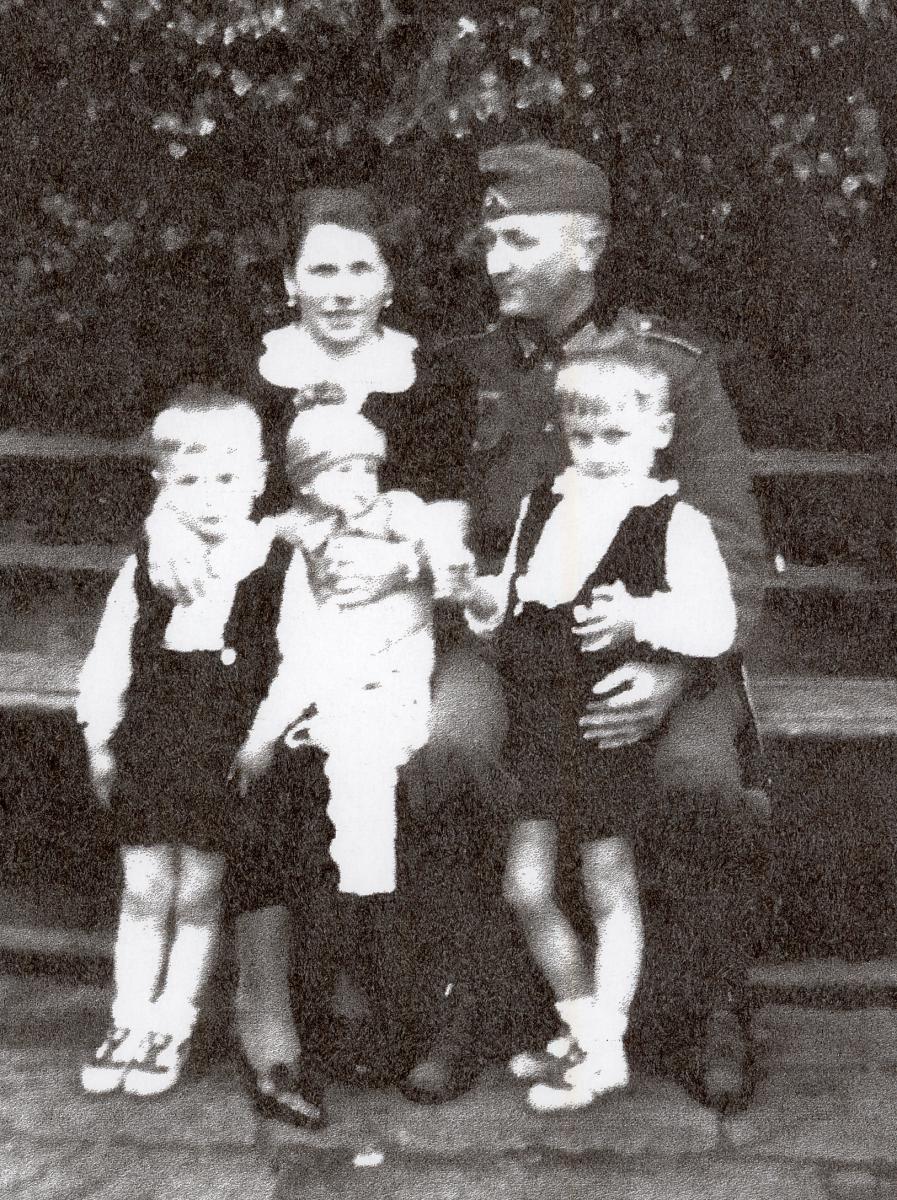 Fig. 3. The Wehrhahn family early in the war. (F. Wehrhahn)
Fig. 3. The Wehrhahn family early in the war. (F. Wehrhahn)
Young Heinz Rahde (born 1927) recalled his midwar service in the Hitler Youth. Along with the obligatory political instruction, the boys were taught a strict code of conduct and were kept constantly busy:
We mainly learned about the life of Hitler, about his movement and his goal. The other time was devoted to sports, hiking, camping, reading maps and compasses. We took trips, roamed through the forests, learned first aid, all the things [American boys] learn in Scouting. . . . It kept us off the street. . . . Once a month we had Sunday morning meeting. They were always arranged at a time when church was held. [10]
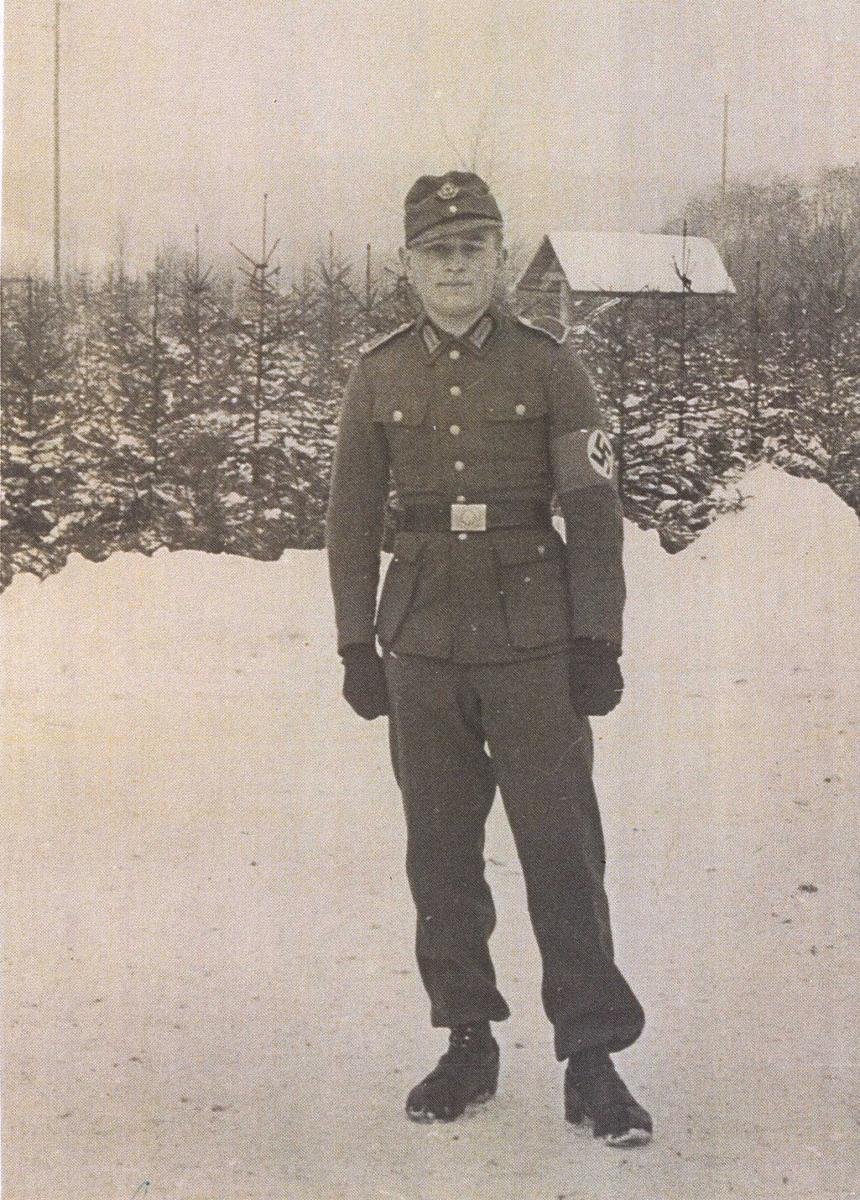 Fig. 4. Heinz Rahde on leave at home in the uniform of the Reichsarbeitsdienst. (H. Rahde)
Fig. 4. Heinz Rahde on leave at home in the uniform of the Reichsarbeitsdienst. (H. Rahde)
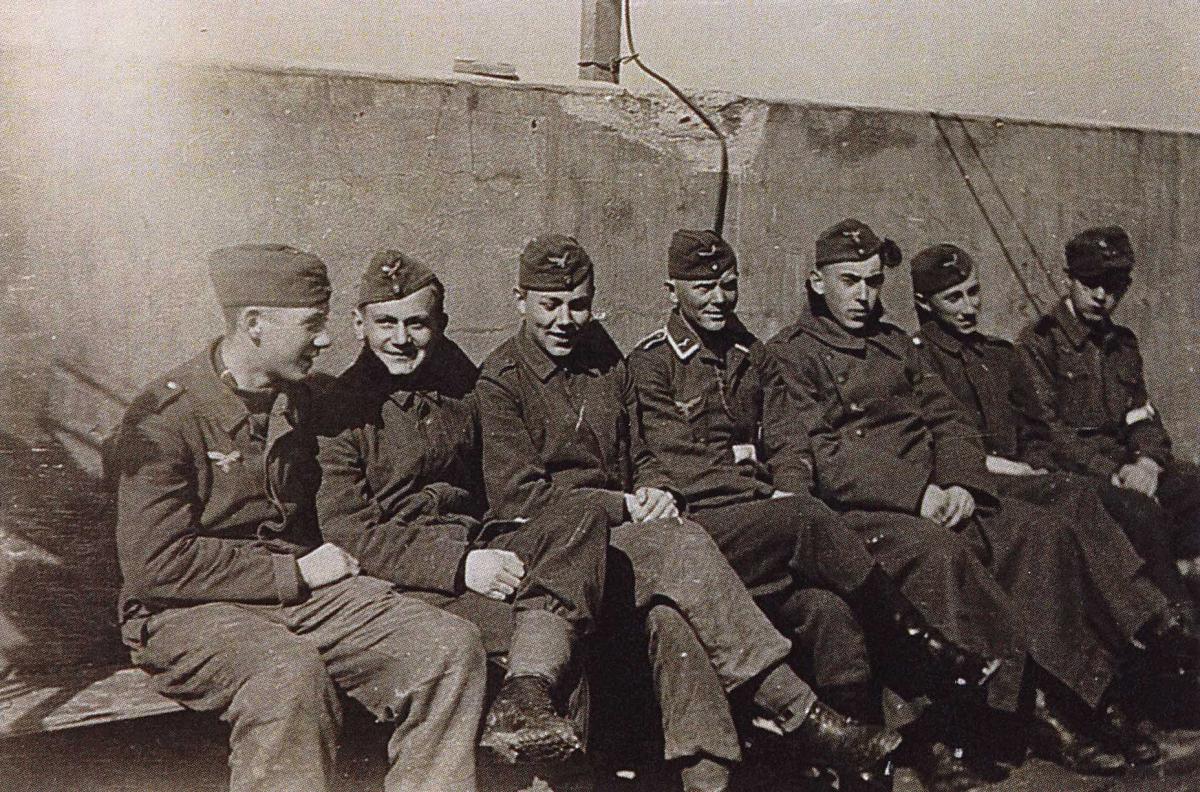 Fig. 5. Heinz Rahde’s young antiaircraft battery comrades. The boys were pupils of the Hölty School in Wunstorf. (H. Rahde)
Fig. 5. Heinz Rahde’s young antiaircraft battery comrades. The boys were pupils of the Hölty School in Wunstorf. (H. Rahde)
Fortunately, Heinz rarely had to miss church meetings. He had been taught gospel principles by his parents and recognized some of the danger signs as he was called upon to serve his country at home and away. At the young age of sixteen, he was commuting about ten miles from his home in Heuerssen to the city of Wunstorf to attend a secondary school.In 1943, Heinz and his classmates were assigned asLuftwaffenhelfer(air force assistants) and trained to operate an antiaircraft battery. Under the command of one of their schoolteachers, they took up quarters on the outskirts of the huge city of Hanover. It was there that Heinz witnessed war at its most horrific on the evening of September 8, 1943. His account conveys the emotion of the experience of a young man trying in vain to defend his homeland:
[Illumination flares] were dropped. . . . [Enemy] planes were all over. We received orders to just shoot in any directions, wherever the noise came from. We rotated the guns continuously and fired as fast as we could. . . . The initial shock was hardly over when a fantastic firework appeared in the sky. Phosphorus bombs were [dropped]. They exploded high in the skies, and the burning tongues of flames danced down. . . . Wherever you looked, there were dancing little flames, dropping slowly down to earth. . . . We were spellbound, standing in awe and fear and desperation, knowing that in minutes, every little inch of the ground would be engulfed in flames. It was a horrible spectacle. [11]
Tens of thousands of residents of Hanover perished in that attack. Heinz Rahde and his friends were compelled to see the aftermath of the bombing with their own eyes when they were transported into town to help rescue persons buried alive or to recover bodies. He would not soon forget the sight: “It was like landing on the moon. Every building was destroyed. There was nothing left of a once proud city, no houses, no anything. . . . We did not find any people alive.”
Although not officially soldiers, members of Heinz Rahde’s antiaircraft unit were constantly in harm’s way, and several were killed during air raids. In addition to the physical dangers, men and boys in uniform were subjected to moral dangers as well. Heinz recalled many instances when girls with loose morals entertained the boys. Alcohol and tobacco were in use all around him, but he clung to the teachings of the Church. He did not explain his health code and thus took some chiding from his comrades. On one occasion, his commanding officer complimented him in a rather surprising fashion. His account of the experience reads:
During a party in the mess hall, he commanded, “Rahde, stand up!” There I stood. I did not know what he wanted. He said, “Rahde is a Mormon. He does not drink, he does not smoke. If you tease him again, I will punish you.” I was a bit ashamed of myself. . . . Then he said, “Rahde, from now on, it is your assignment to bring your friends back to the battery compounds, whenever they go out and have too much to drink.” I did. I never had more friends since. They all wanted me to go with them. [12]
The Saints of the Stadthagen Branch were few in number but were not forgotten by the leaders of the West German Mission. On April 12, 1942, Anton Huck (first counselor to mission supervisor Christian Heck) attended meetings in Stadthagen and ordained Friedrich Behling an elder. One year later, both Elders Heck and Huck were in Stadthagen to hold a special meeting. By then, the average attendance had increased to about fifteen persons. On July 11, 1943, the Relief Society held a conference to which twenty-three members and friends came. The theme was “keeping the Sabbath day holy.” [13]
“We had very many air raids in our area,” according to Fred Wehrhahn. “It started in 1942 and got more severe as time went on. At first, we would always hear an ‘attention getter’ and the sirens would go off. As the planes came closer, the sirens would go off again. When we heard two long, loud sounds, it meant that we had to find a shelter somewhere. Three sounds meant that they were here.”
Small deeds of compassion on the part of young Heinz Rahde would return blessings upon his head later on. As an air force assistant, he came into contact with Russian POWs. They were assigned to clean the mess kits of the German soldiers, and Heinz was in the habit of leaving portions of his meals for them, knowing that they were underfed. On one occasion, his commanding officer noticed the clandestine act and asked Heinz, “What did you put in your mess kit?” “Food,” answered Heinz. “They’re hungry.” The officer patted him on the shoulder and said, “Don’t do that again. If I reported you, it could cost you your life.” One Russian prisoner eventually wrote a note and gave it to Heinz with this comment: “When Germany loses and you need some help from the Russians, show them this little note.” [14] Heinz preserved the note with care.
Karl Wehrhahn was among the Wehrmacht soldiers trying to stave off the Allied invasion of France in Normandy in June 1944 and was captured there by British soldiers. He later told his son, Fred, that while he and other German soldiers were being guarded by a nervous British soldier, the young man accidentally fired his weapon, inflicting a mortal wound on the soldier standing next to Karl, who had been praying that no such incident would occur.
Heinz was seventeen in 1944 when a call came to national service in the Reichsarbeitsdienst(RAD). This duty was almost a like a vacation when compared with the high-stress, no-rest duty he had rendered in ground-to-air combat. His RAD unit was stationed in the village of Münchehof near the picturesque town of Seesen, just fifty miles southeast of his home. A bright young man and a good student, Heinz became a trainer responsible for instructing boys fifteen and sixteen in the use of radar equipment. He enjoyed the assignment, the natural beauty of the setting, and the proximity to home.
An opportunity for advancement and prestige presented itself while Heinz was at Münchehof. His performance was so good that he was invited to join an officers’ training program. However, he turned down repeated invitations. He later came to the conclusion that the Lord must have been with him in making that decision: “All of my friends left [to join the program]. They were sent to Russia, and over 80 percent of them died. . . . I could stay in Germany, training incoming recruits on our antiaircraft instruments. I felt I was a good teacher.” [15]
The year 1944 was one of slight growth for the Stadthagen Branch. On February 20, three members of the Kirchhöfer family (Edith, Ursula, and Heinz) were baptized in a ceremony held in connection with a district conference in Bielefeld. By this time, many members of the branch had left town to serve in the military or in other government assignments to the extent that the Thanksgiving program held on October 8 was attended by only eleven persons. [16]
Fred Wehrhahn recalled being treated differently because of his religion:
As soon as people at school found out that we were members of the Church, we were quite frankly treated as second-class citizens. They were careful about it, but even as a child, I realized that I was not treated the same as others were. Even the people in our neighborhood knew that we were [Latter-day Saints], especially because my dad always liked sharing the gospel with others. I still had friends in the neighborhood to play with, and it did not matter much to them. But I have to say that it was not the kind of persecution that made us suffer.
On November 26, the Sunday School had to be canceled due to air-raid alarms. On Christmas Day, district president Alfred Hegemeister from Stadthagen visited the branch meetings and guided a discussion about moving the meetings to Sunday morning, because the local Volkssturm (home guard) was conducting training on Sunday afternoons. The members of the branch voted to decline the suggestion. [17]
As the war drew to a close, the Saints in Stadthagen continued to hold their meetings as best they could. On March 18, 1945, a branch anniversary celebration was held, and nineteen persons attended. Three weeks later, the minutes note that no meetings could be held because American soldiers had conquered the surrounding county of Schaumburg-Lippe. British troops moved into the town on April 15, and again church meetings were canceled. The next entries are of postwar events, such as on May 20, when Sunday School was scheduled for 9:30 a.m., to be followed by sacrament meeting. Although church services had been canceled on several occasions, the branch secretary continued to make his entries without interruption. [18]
Werner Jacobi had finished public school in 1943 and began an apprenticeship as a plumber and electrician. He rode his bike every day to Barntrup, a town three miles to the south. His services there were valuable because so many young men had left their masters’ shops to serve in the military. Werner was still there when the war drew to a close, and he was drafted into the Volkssturm. Given some training with weapons, he was eventually sent with other citizen soldiers toward Berlin. “We were supposed to march to Berlin in order to defend Hitler. We only made it as far as Rinteln [twelve miles north of Alverdissen] because somebody had destroyed a bridge, and then we had to walk back home. After that, the British army came to our area. There was no fighting.” At age seventeen, Werner was very fortunate to avoid dangerous military service.
In the spring of 1945, the Soviet army was driving toward Berlin, and an order came that Heinz Rahde’s unit was to race to the German capital to join in the defense of the city. Heinz and two close friends, Günther Abeler and Ali Behrens, deliberated and decided that they were not going to Berlin—they were going home! They found civilian clothing, gathered a supply of food, and headed for the forest. Despite moving toward home with great caution and keeping out of the open, they suddenly found themselves staring down the cannon barrel of an American tank. After the initial terror of facing the enemy for the first time, the boys were interrogated and were about to be shipped off to a POW camp. When he saw several freed Russians sitting on the tank, Heinz recalled the note and displayed it with high hopes. The Americans were impressed and instructed him, “Go home to your mother.” [19] He must have been very grateful for the training he had received in treating his fellowman properly.
On the way home, Heinz and his friends traveled under cover of the forests until one day, when he felt inspired to go into the open. This seemed foolish to his friends, because they had watched from afar as enemy truck after truck transported German soldiers to POW camps. Nevertheless, Heinz wanted to leave the forest. Günther inquired, “Heinz, did you pray about it?” “Yes!” “Then I go with you.” Moments later, they were invited by a local farmer to hide in a barn. While they did so, American soldiers searched the forest they had left and rounded up many German prisoners. Heinz recalled recognizing the hand of the Lord in this escape. [20]
Finally, the boys found themselves looking down the hill at Heinz’s village of Heuerssen and were pleased that no damaged had occurred. While sneaking into the backyard, Heinz set off a burglar alarm that sounded like a small bomb. Fortunately, only the family and the neighbors reacted and were thrilled to see Heinz. “What a joy that was! I was home. I cannot describe the feeling. Home, with mother, father and sister.” His sister took food to his friends at the outskirts of town, after which they headed in different directions to their respective homes. [21]
There would be one more confrontation with the conquering Americans, but this one was quite harmless. A few days after arriving home, Heinz was still hiding, hoping to avoid being taken away to a POW camp. He had never officially belonged to the Wehrmacht, but in those days, any man in uniform could be considered a soldier and incarcerated. One day, some American soldiers in a tank showed up in front of the Rahde home and called for Heinz. It turned out that the town’s mayor had identified him as the only one who could speak English. The soldiers were looking for a guide through the local forest to hunt deer. Heinz joined them, and they even gave him a gun. “For the first time I began to trust our enemy.” [22]
Fred Wehrhahn was approaching his eighth birthday when World War II came to an end. He recalled the chaos and insecurity of the times:
I remember that soldiers often came to our home and asked for civilian clothing. They would leave all their uniforms with us. We were told to prepare ourselves for the Russians to come in when the war came to an end. We packed bare necessities to put on our little wagon, and we were just waiting to hear who would come. In the end, it was the Americans. Even as old as I was, I had already heard stories about the Russians and how ugly they were to people. We also heard some things about the Americans.
As it turned out, Fred and his family were not in danger when the conquerors arrived:
When the Americans then came in with their jeeps, they were loaded with clothing and would give it to us to use. I still remember how nice some of those soldiers were to us and how they smiled. They tried in their own way to communicate with us that they were our friends. I got some chocolate from them once, and I got really sick from it because my stomach was not used to it anymore. We were nothing but skin and bones. The Americans took over one of the homes and made it their communication center. I remember that we heard of what they did with the food when they were full and did not want it anymore—they buried it. But we dug it out and hid it underneath our shirts because we were so hungry. I got caught one time, but I wasn’t punished. All my friends ran away, but the sergeant caught me by the neck. He looked at the can that we had found that they buried. He took me on his jeep and didn’t take me home until late at night. I had to go on all his rounds with him.
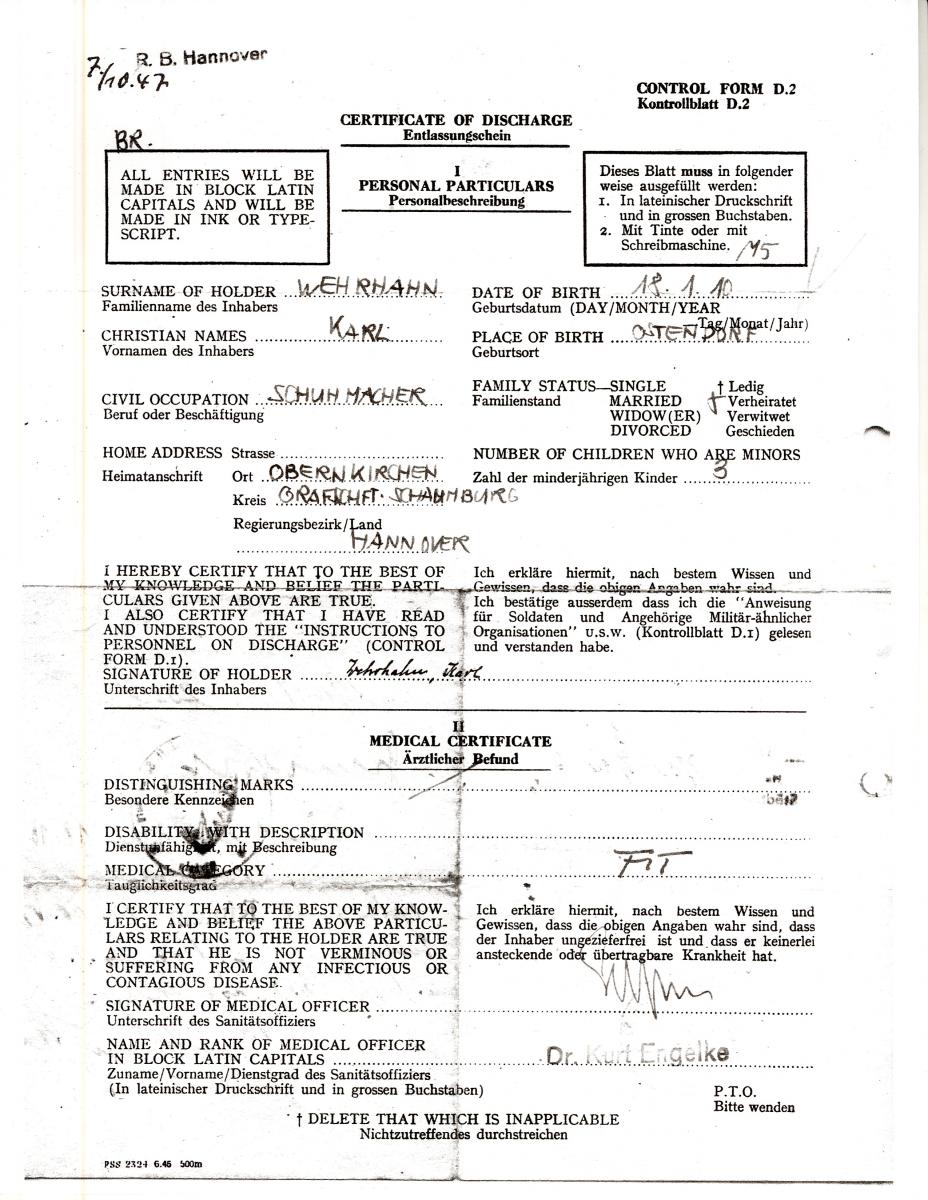 Fig. 6. The official release papers for POW Karl Wehrhahn. (F. Wehrhahn)
Fig. 6. The official release papers for POW Karl Wehrhahn. (F. Wehrhahn)
When World War II ended, Heinz Rahde was only seventeen years old, but he had experienced the horrors of war. He emerged unscathed physically as well as spiritually. Having been perhaps in greater danger of losing his good standing in the Church than losing his very life, he had withstood all temptations and conducted himself as a worthy Latter-day Saint. He had been preserved by the hand of the Lord and was pleased to acknowledge that fact.
The small group of Saints in Alverdissen had survived the war. Their little town was untouched by the conflict, and the British conquerors did no harm as they came through in April 1945. Nevertheless, the times had been difficult in many regards, and in the recollection of Werner Jacobi, “We were very happy that the war was over.”
By the summer of 1945, Karl Wehrhahn had been moved to a POW camp in Canada. Coincidentally, he was then only about fifty miles from his brother, who had emigrated from Germany in the early 1920s. Unfortunately, Canadian officials denied the two any opportunity to meet during Karl’s stay in the region. The brothers would never see each other again.
Karl Wehrhahn did not return to his family until 1947, having been absent from them with rare exceptions since 1939. When he arrived home, he learned that he almost missed seeing his son Fred alive again because of a bizarre incident that occurred a few months after the war:
I remember that [cleanup crews] took out the ammunition out of the woods that were close to our housing complex. They detonated them and destroyed them that way. I nearly was killed during one of those explosions. I was outside helping my mother to saw some logs for firewood. We had been told that when they started exploding those bombs, they would indicate that with a siren so we would know when to go inside to be safe. We kept ignoring it because we really needed the wood that day. A piece of shrapnel came flying through the air and passed me very close to my head. It hit the house and left quite a lot of damage. My mother was so pale—she dropped the saw and demanded that I go with her immediately. We then went inside to be safe. I would say that the piece of metal was about a foot in diameter.
Karl Borcherding Sr. had served his small branch well as its president during the entire war. When the fighting ended and nearly all of the soldiers of the Stadthagen Branch came home, he gathered the members of the branch together to begin a new phase of church life.
In Memoriam
The following members of the Stadthagen Branch did not survive World War II:
Friedrich Conrad Wilhelm Botheb. Wendthöhe, Stadthagen, Schaumburg-Lippe, 30 Aug 1920; son of Friedrich Wilhelm August Bothe and Ernestine Stahlhut; bp. 10 May 1929; conf. 10 May 1929; ord. deacon 7 Jan 1940; rifleman; d. in field hospital 906 at Witebsk, Weißrussland, 15 Feb 1942 (FHL microfilm 68805, no. 8; FHL microfilm 245288, 1930 census; www.volksbund.de; IGI)
Johann Heinrich Otto Desenisb. Beckedorf, Grafschaft Schaumburg, Hessen-Nassau, 12 Jun 1861; son of Otto Desenis and Anna Knolle; bp. Minden, Westfalen, 31 Aug 1918; conf. 31 Aug 1918; ord. deacon 12 Oct 1919; ord. teacher 17 Apr 1921; m. 19 Jul 1891, Anna Sophie Charlotte Engelking; five children; d. senility 13 Dec 1944 (CR Bielefeld Branch; FHL microfilm 68805, no. 19)
Anna Sophie Charlotte Engelkingb. Beckedorf, Grafschaft Schaumburg, Hessen-Nassau, 16 May 1867; dau. of Hans Heinrich Konrad Engelking and Engel Marie Sophie Charlotte Meier; bp. 31 Aug 1918; conf. 31 Aug 1918; m. 19 Jul 1891, Johann Heinrich Otto Desenis; five children; d. senility 24 Jan 1942 (CR Bielefeld Branch, FHL microfilm 68805, no. 18; 68784, no. 2; IGI)
Friedrich Johann Wilhelm Ludwig Kirchhöferb. Reinsen, Stadthagen, Schaumburg-Lippe, 12 Nov 1861; son of Christian Ludwig Kirchhöfer and Anne Sophie Karoline Oltrogge; bp. 6 Nov 1926; conf. 6 Nov 1926; ord. deacon 17 Jun 1928; ord. teacher 7 Apr 1929; ord. priest 25 Jan 1931; m. Heuerßen, Stadthagen, Schaumburg-Lippe, 26 Apr 1891, Engel Marie Sophie Oltrogge; d. bronchitis and heart ailment 20 May 1940 (FHL microfilm 68805, no. 34; 1925 and 1930 censuses, no. 271379; IGI; AF) (Bro. Minert: we are a little confused with some of these microfilm numbers. In this note, there is a semicolon separating “FHL microfilm 68805, no. 34” and “1925 and 1930 censuses, no. 271379,” as if the microfilm and the census are two separate sources. In other sections there is a comma separating the microfilm number and the census info., implying that the censuses arecontained inthe microfilm. The same type of thing happens in other places, for example under Anna Sophie Charlotte Engelking. There it says “CR Bielefeld Branch, FHL microfilm 68805, no. 18.” Does this mean the Bielefeld branch record is contained on FHL microfilm 68805, no. 18, or are they two separate sources (in which case we would separate them with a semicolon)? If you could clarify this, we could make appropriate adjustments throughout the book.)The better way to cite this one source would be: CR Bielefeld Branch, record no. 18, FHL microfilm 68805.
Friederike Karoline Charlotte Maierb. Rolfshagen, Grafschaft Schaumburg, Hessen-Nassau, 12 Mar 1860; dau. of Johann Friedrich Willhelm Maier and Karoline Justine Kinne; bp. 11 Oct 1924; conf. 11 Oct 1924; m. Obernkirchen, Grafschaft Schaumburg, Hesseb-Nassau, 15 May 1880, Karl Heinrich Friedrich Tünnermann; 2m. 8 Apr 1908, Wilhelm Albes; d. old age Rolfshagen, 5 May 1943 (FHL microfilm 68805, no. 1; CR Bielefeld Branch, FHL microfilm 68784, no. 28; FHL microfilm 25708, 1930 census; IGI)
Engel Marie Sophie Oltroggeb. Heuerßen, Stadthagen, Schaumburg-Lippe, 19 Jun 1866; dau. of Johann Heinrich Konrad Oltrogge and Engel Marie Charlotte Hardekopf; bp. 7 May 1927; conf. 7 May 1927; m. Heuerßen, 26 Apr 1891, Johann Friedrich Wilhelm Ludwig Kirchhöfer; d. stroke Reinsen, Stadthagen, Schaumburg-Lippe, 17 Jun 1940 (CR Bielefeld Branch, FHL microfilm 68784, no. 74; IGI)
August Heinrich Friedrich Christian Römbkeb. Seelenfeld, Minden, Westfalen, 25 Apr 1859; son of Johann Konrad Dietrich Römbke and Sophie Schröder; bp. 14 Oct 1922; conf. 14 Oct 1922; ord. deacon 22 Jul 1923; ord. teacher 6 Jul 1926; ord. priest 20 Mar 1931; m. Stadthagen, Schaumburg-Lippe, 8 Jan 1887 to Sophie Karoline Dorothee Schäfer; d. stroke 9 May 1941 (CR Bielefeld Branch, FHL microfilm 68784, no. 11; FHL microfilm 68805, no. 46; IGI)
Sophie Karoline Dorothie Schäferb. Lachem, Hameln, Hannover, 16 or 17 Aug 1867; dau. of —— and Dorothie Rosine Schäfer; bp. 11 Sep 1921; conf. 11 Sep 1921; m. 11 Jan 1887, August Heinrich Friedrich Christian Römbke; d. lung disease, Stadthagen, Schaumburg-Lippe, 4 May 1940 (FHL microfilm 68805, no. 47l; CR Bielefeld Branch, FHL microfilm 68784, no. 7)
Friedrich Wilhelm Ludwig Scheperb. Stadthagen, Schaumburg-Lippe, 14 Nov 1885; son of Ernst Scheper and Gustine Thies; bp. 17 Dec 1926; conf. 17 Dec 1926; m. 2 Jan 1909, Anna Christine Nagel; d. pulmonary tuberculosis 19 May 1940 (CR Bielefeld Branch, record no. 50, FHL microfilm 68805)
Karoline Sophie Vehlingb. Wendthagen, Stadthagen, Schaumburg-Lippe, 16 Nov 1867; dau. of Ludwig Vehling and Auguste Runge; bp. 9 Feb 1929; conf. 9 Feb 1929; m. Heinrich Wilhelm Hartmann; d. senility 2 Feb 1944 (CR Bielefeld Branch, FHL microfilm 68784, no. 109; IGI)
August Friedrich Wehrhahnb. Ostendorf, Rinteln, Hessen-Nassau, 24 May 1867; son of Heinrich Karl August Wehrhahn and Mathilde Henriette Schwoone; bp. 3 Jun 1933; conf. 3 Jun 1933; ord. deacon 28 Feb 1937; ord. priest 7 May 1939; m. 7 Apr 1888, Minna Antoinette Dorothee Tebbe; three children; m. 15 Dec 1894, Engel Wilhelmine Justine Schmidt; thirteen children; m. 24 Mar 1920, Luise Requardt; d. peritoneal cancer, Engern, Hessen-Nassau, 24 Dec 1939 (FHL microfilm 68805, no. 67; IGI)
Anne Sophie Dorothee Willsb. Beckedorf, Rinteln, Hessen, Nassau, Hessen-Nassau, 11 Jun 1855; dau. of Johann Heinrich Wilhelm Wills and Christine Sophie Charlotte Dühlmeyer; bp. 11 Sep 1921; conf. 11 Sep 1921; m. Blyinghausen, Schaumburg-Lippe, 4 Nov 1880, Heinrich Friedrich Wilhelm Bredthauer; d. 1 Feb 194. (IGI; CR Bielefeld Branch, FHL microfilm 68784, no. 6; FHL microfilm 25728, 1925 census)
Notes
[1] Stadthagen city archive.
[2] West German Mission manuscript history, CHL MS 10045 2.
[3] Fred Wehrhahn, telephone interview with the author, April 30, 2009.
[4] Presiding Bishopric, “Financial, Statistical, and Historical Reports of Wards, Stakes, and Missions, 1884–1955,” 257, CHL CR 4 12.
[5] Stadthagen Branch general minutes, 183, CHL LR 8676 11.
[6] Ibid., 193, 200.
[7] Ibid., 226, 234, 241.
[8] Werner Jacobi, telephone interview with the author in German, April 13, 2009; summarized in English by Judith Sartowski.
[9] Stadthagen Branch general minutes,230.
[10] Heinz Rahde, autobiography (unpublished), 19.
[11] Ibid.,20.
[12] Ibid., 22.
[13] Stadthagen Branch general minutes, 232.
[14] Rahde, autobiography,25.
[15] Ibid., 24.
[16] Stadthagen Branch general minutes.
[17] Ibid.
[18] Ibid.
[19] Rahde, autobiography,25.
[20] Ibid.,26.
[21] Ibid., 27.
[22] Ibid., 28.
